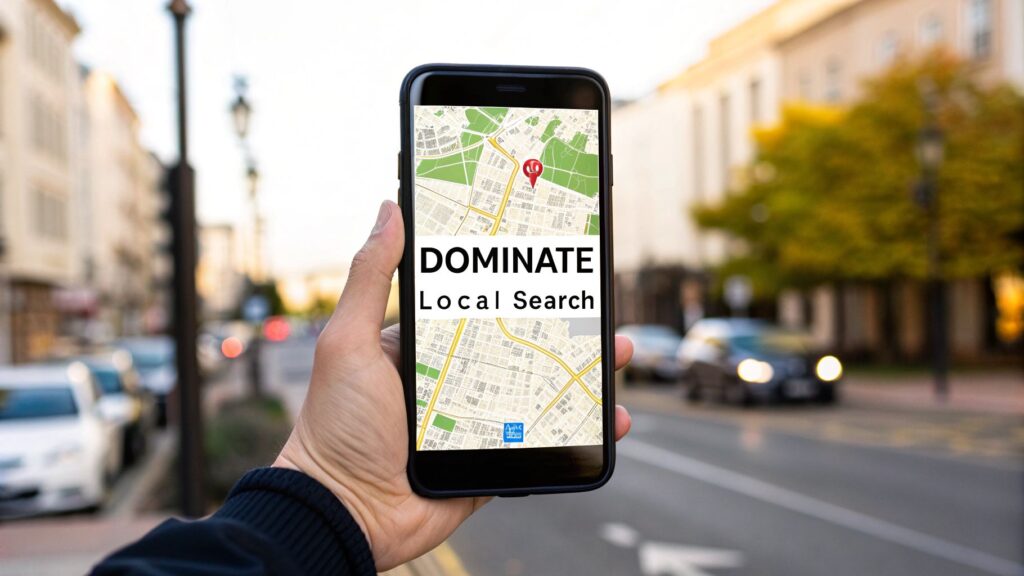If your business plan relies only on Instagram's algorithm and word-of-mouth, you're building on shaky ground. Think of SEO for wedding photography as your silent, 24/7 booking assistant. It works in the background, putting your portfolio in front of couples searching on Google for a photographer just like you.
It’s about getting found when a couple needs you. This creates a steady flow of inquiries without the constant hustle.
In Short: SEO helps ideal clients find your wedding photography website on Google, leading to more consistent bookings.
Why SEO Is Your Best Client Magnet
Ever feel like you're shouting into the social media void? SEO is the opposite. Instead of you pushing your work out and hoping the right person sees it, SEO pulls in couples who are already looking.
They’re typing phrases like "adventurous elopement photographer in Colorado" or "light and airy wedding photographer in Charleston" into Google. You just need to be the answer they find.

The wedding photography world is crowded. It feels like everyone with a nice camera is a "professional." That saturation is why showing up on the first page of Google is non-negotiable. A huge 75% of people never click to the second page.
Suddenly, SEO isn't just a techy chore; it's your best way to get leads. You can read more on why SEO is crucial for photographers at joseangelostudios.com.
No Jargon, Just Results
Don't worry, the goal here isn't to turn you into a coder. It's about understanding a few key ideas that connect your beautiful work with your ideal clients.
A solid SEO plan helps you:
- Get Better Inquiries: This means couples who have already seen your portfolio, love your style, and understand your value before they even email you.
- Build Real Authority: An Instagram post is gone in 48 hours. A blog post that ranks well can bring you business for years.
- Stress Less About Marketing: Imagine waking up to inquiries that came in while you were sleeping. That’s what good SEO does.
The bottom line: SEO for your wedding photography business isn't about technical wizardry. It’s simply about making it easy for the right couples to find you, love your work, and book you. That's how you build a lasting business.
Discovering Keywords That Attract Dream Clients
Keyword research is the foundation of a solid SEO for wedding photography strategy. This isn't about guessing what couples are searching for. It's about finding the exact phrases they're typing into Google.
Forget generic terms like "wedding photographer." The real magic is in long-tail keywords. These are longer, more descriptive phrases. They signal serious intent and bring you couples who are ready to book.

For example, a couple might not just search for a "photographer." They'll search for "candid wedding photographer for a mountain elopement." Someone with a venue might search for "Austin wedding photographer Zilker Park." These couples are ready to book.
How to Find Your Core Keywords
You don't need expensive software to start. Some of the best tools are free. You can build a great keyword list just by paying attention. Your goal is to figure out what real couples are asking.
Start with Google itself. Type a broad term like "New York wedding photographer" into the search bar and scroll down. Look for the "People Also Ask" box.
That little box is a goldmine for content ideas. It's Google handing you the questions people are asking about your services. These make perfect blog post titles or FAQ sections.
You’ll see questions like:
- How much does a good wedding photographer cost in NYC?
- What is the average price for wedding photography in Brooklyn?
- What should I look for in a wedding photographer?
Each one of those is a keyword phrase you can build content around. They offer a direct line into the needs of your potential clients.
Building Your Starter Keyword List
Let's get practical. Your first goal is to brainstorm a list of 10-15 core keywords. These will be the foundation for your main website pages and first few blog posts.
Think in terms of categories:
- Location-Based: This is essential for a local business. Think "[Your City] wedding photographer" or "[Neighborhood] engagement photos."
- Style-Based: This attracts couples who vibe with your creative style. Keywords like "light and airy wedding photos" or "documentary style wedding photographer" work well.
- Venue-Specific: Couples love seeing photos from their venue. A keyword like "photos at [Venue Name]" can be very powerful.
When you mix and match these, you create specific long-tail keywords like "moody wedding photos at The Greenpoint Loft." Targeting specific phrases helps you stand out from the competition and speak directly to your ideal couple.
If you want to go deeper, our guide on discovering keywords that attract dream clients has more detail. This process turns a simple online portfolio into a machine that brings you new clients.
How To Get Your Website Ranking On Google
So, you have a list of keywords ready to go. Now it's time to put them to work on your website. This is called on-page SEO. It’s all about placing those keywords in the right spots so both Google and clients know what you’re about.
Think of your website as a storybook. Your page titles and descriptions are like the cover. They need to be interesting enough to make someone want to open it.
Nail Your Titles And Descriptions
The title tag is the clickable blue headline you see in Google search results. It’s one of the most important pieces of on-page SEO. The meta description is the short text below it. While it doesn't directly boost rankings, a great one can convince someone to click on your site.
Here’s a simple formula:
- Title Tag: [Your Main Keyword] | [Your Business Name]
- Meta Description: A warm sentence that uses your keyword and encourages a click.
Let’s imagine you’re a photographer in Austin. Here’s what that looks like:
Title Tag Example: Austin Wedding Photographer | Jane Doe Photography
Meta Description Example: Capturing authentic, joyful wedding stories in Austin, TX. Looking for a photographer who values real moments? See my portfolio and get in touch!
It’s that easy. Go into your website's backend (Squarespace, WordPress, etc.) and find the SEO settings for your important pages. Add your titles and descriptions there.
Turn Your Portfolio Into An SEO Powerhouse
Many photographers miss this. They treat their portfolio as just a pretty gallery, but it’s an SEO goldmine. Every wedding you feature is a new chance to tell Google what you do and where you do it.
It starts with your image file names, before you upload them. Ditch the generic _DSC1234.jpg.
- Bad File Name:
IMG_9876.jpg - Good File Name:
austin-wedding-photographer-zilker-park.jpg
See the difference? One tells Google nothing, the other tells it everything.
Once the image is uploaded, you must add alt text. This is a brief description of the photo that helps visually impaired users and search engines understand the picture. It's the perfect spot to include your keywords naturally.
- Good Alt Text: A candid photo of a bride and groom laughing at their Zilker Park wedding in Austin, captured by Jane Doe Photography.
Following this simple workflow for your website content and images sends strong signals to Google about what your pages are about.

When you consistently optimize your titles, write compelling descriptions, and add detailed alt text to your images, you make it clear to Google why you deserve to rank for your target keywords.
On-Page SEO Checklist for Photographers
| SEO Element | What to Do | Example |
|---|---|---|
| Title Tag | Include your primary keyword near the beginning. | "Miami Wedding Photographer | Your Name" |
| Meta Description | Write a compelling, 155-character summary. | "Capturing vibrant, timeless love stories in Miami, FL. View my work and let's chat!" |
| URL Slug | Keep it short and keyword-focused. | /miami-wedding-photographer |
| H1 Heading | Use your primary keyword once on the page. | "Miami Wedding & Elopement Photographer" |
| Image Alt Text | Describe the image with relevant keywords. | "Bride and groom kiss at Vizcaya Museum wedding in Miami." |
| Image File Name | Name files with keywords before uploading. | vizcaya-wedding-miami-photographer.jpg |
This little checklist is your best friend. Use it every time you publish a new blog post or gallery.
Speed and User Experience Matter
You can have a perfectly optimized page, but if your website is slow or hard to use on a phone, it doesn't matter. A site that takes longer than 3 seconds to load will lose many of its visitors.
Google knows this and favors websites that are fast, secure, and mobile-friendly.
To give your site the best chance at ranking, it’s important to follow current website design best practices. For photographers, this means compressing your images before you upload them and making sure your site works well on a smartphone.
In Short: Good on-page SEO makes your website clear to both Google and your dream clients, using keywords smartly while ensuring your site is fast and easy to use.
Mastering Local Search and Google Maps
For most wedding photographers, business is local. You want to be the go-to photographer in your city. That’s why dominating local search is everything. The key is your Google Business Profile (GBP).
Think of your GBP as your digital storefront on Google. For many couples, it's their first impression of you. A well-managed profile can land you in the "Map Pack," the box with three businesses at the top of the search results. Getting in there is a game-changer.

Ignoring local SEO is a missed opportunity. Over 78% of couples with luxury wedding budgets found and hired their vendors, including photographers, from a Google search. This shows how critical a strong search presence is.
Getting Your Google Business Profile Just Right
Claiming your profile is the easy part. The real work is filling out every single section. Google loves details and rewards complete profiles.
- Business Name: Use your actual business name. Don't add keywords like "Jane Doe – Denver Wedding Photographer." It looks spammy.
- Categories: Your main category must be "Wedding photographer." Then, add related categories like "Photographer" or "Portrait studio."
- Service Area: Be specific. List the cities, counties, or neighborhoods you serve. This tells Google where to show your profile.
- Services: Don't just list "wedding photography." Break it down into "Elopement Packages," "Engagement Shoots," and "Full-Day Wedding Coverage."
My Two Cents: A detailed Google Business Profile sends a powerful signal to Google. It says, "I'm a real, active business in this area." The more info you provide, the more they will trust and recommend you.
The Power of Reviews and Photos
Reviews are gold for local SEO. They provide social proof and are a big ranking factor for the Google Map Pack. Create a simple system to ask for a review after delivering the final gallery.
Also, respond to every review. A quick "thank you" shows you are engaged and care about your clients.
Photos are just as important. You're a photographer! Regularly upload your best work from recent weddings. Show a variety of venues and couples. Also, add a few shots of yourself to build trust.
Keeping Your Citations Consistent (NAP)
Google checks your business information across the web. This is where NAP consistency comes in—that’s your Name, Address, and Phone Number. This information must be identical everywhere.
Check your details on:
- Wedding directories like The Knot or WeddingWire
- Your Facebook, Instagram, and Pinterest profiles
- Your website's footer and contact page
Mismatched information confuses Google and can hurt your local rankings. Take 30 minutes to audit your online presence and fix any issues.
Turn Your Blog into a Client-Booking Machine
Your blog is one of the most powerful SEO tools you have. Stop treating it like a place to just dump photos. Think of it as your best salesperson, working 24/7 to attract and educate your ideal clients.
When you shift from just posting pictures to creating helpful content, you build a resource. You establish yourself as the go-to expert in your market. This attracts couples who are looking for a trusted pro, not just the cheapest price.
From Photo Dump to Strategic Resource
The old photographer blog post is familiar: 50 images from a wedding and a quick "congrats to the couple." This does almost nothing for your SEO because it doesn't answer any questions a couple is typing into Google.
The new approach is to target a specific, long-tail keyword with every blog post. Each article becomes a new front door to your business.
Here are a couple of examples:
- Venue-Focused Guides: Instead of "Jane & John's Wedding," create "A Photographer's Guide to Getting Married at The Greenpoint Loft." This grabs the attention of couples considering that venue.
- Answering Common Questions: Turn frequently asked questions into blog posts. A title like, "How Many Hours of Wedding Photography Do You Actually Need?" is perfect for capturing couples in the planning phase.
This strategy is effective because you meet couples where they are. You provide real value and solve their problems. That builds trust before they even contact you.
How Google is Changing the Game for Photographers
Google is getting smarter. SEO for wedding photographers is changing because of things like AI Overviews, where Google summarizes the best answer at the top of the page. This means the game has changed from just ranking for keywords to proving your content is genuinely helpful.
For you, this means creating high-quality, conversational content that directly answers questions. This makes a strong case for writing thoughtful blog posts instead of just portfolio dumps. You can see more on this for 2025 over on narrative.so.
The Power of Internal Linking
As you build a library of content, you unlock another SEO advantage: internal linking. It's simple. When you publish a new post, look for chances to link to your other relevant articles and your main service and contact pages.
In a guide for "The Greenpoint Loft," you could link to:
- A post about the "Best First Look Locations in Brooklyn."
- Your main portfolio page with other industrial-chic weddings.
- Your contact page with a call-to-action like, "Thinking about The Greenpoint Loft? I'd love to capture it for you."
This creates an interconnected web on your site. It keeps people clicking, which signals to Google that your site is a valuable resource. It also guides a reader straight to your inbox.
For a deeper dive, check out our complete guide on SEO for wedding photographers.
Frequently Asked Questions About Wedding Photography SEO
Diving into SEO can feel overwhelming. It's normal to have questions. This quick FAQ tackles the most common things photographers ask.
How long does it take for SEO to work?
This is the big one. SEO is a long game, not an overnight fix. You're planting seeds that grow over time.
Realistically, you should see small signs within 3 to 6 months. This might be a bit more traffic from Google or more people finding your Google Business Profile.
For solid, first-page rankings that bring in consistent inquiries, you’re typically looking at 6 to 12 months. Your local market competition and consistency play a big part.
In Short: Patience is key. SEO that generates a steady stream of dream clients usually takes 6-12 months of focused work.
Is blogging necessary for SEO?
Yes, absolutely. It's probably the most powerful tool you have. Your main website pages can only target a few broad keywords, like "chicago wedding photographer."
Your blog, however, lets you create endless content that answers specific questions your ideal clients are asking Google.
For instance, you can write blog posts targeting:
- "Best Chicago rooftop wedding venues"
- "What to wear for an engagement shoot in Lincoln Park"
- "A real wedding at The Drake Hotel"
Each post is a new doorway for potential clients to find you.
What should I look for in a wedding photographer?
Couples should look for three main things in a wedding photographer:
- A Style You Love: Look through their portfolio. Do their photos feel bright and airy, dark and moody, or classic and timeless? Make sure their artistic style matches the vision you have for your wedding day.
- Positive Reviews and Experience: Check their reviews on Google and wedding directories. Do past clients talk about their professionalism, personality, and the quality of their work? An experienced photographer will also know how to handle tricky lighting and unexpected moments.
- A Personality You Connect With: You'll spend most of your wedding day with your photographer. It's important that you feel comfortable and relaxed around them. Schedule a call or meeting to see if your personalities click.
What SEO tasks matter most for photographers?
If you're feeling overwhelmed, just breathe. Focus on these four key things, and you'll be ahead of most of your competition.
- Local SEO: Your Google Business Profile is your best friend. Keep it optimized and updated to show up in the Google Maps pack.
- On-Page SEO: Make it clear to Google what your pages and photos are about. Use keywords in your page titles, headings, and image alt text.
- Helpful Content: Use your blog to share content your ideal clients are searching for, like venue spotlights and planning advice.
- Backlinks: When other reputable sites link to your website, it's a massive vote of confidence in Google's eyes. It tells search engines you're a trusted professional.
At Clicks Geek, our focus is on crafting SEO strategies that turn your website into a client-booking engine. If you're ready to get more inquiries from your dream clients without the marketing headache, let's talk about growing your photography business.
Is Your Business Ranking in Google Maps?
Turn Google Maps into a Lead Engine w/ Clicks Geek’s AI-powered local SEO. 3,000+ clients served. Our proprietary, fully done-for-you Maps SEO system handles everything—keyword targeting, local optimization, content, reviews, and ranking strategy—automatically.






